Tessa’s Recipe Rundown
Taste: This recipe is perfectly balanced with warm pumpkin spice, a hint of tang from the cream cheese filling, and just the right sweetness.
Texture: Buttery, crunchy cookie crust + silky smooth filling + fluffy whipped topping = pure texture heaven.
Ease: You’ll be surprised how simple this recipe is (no water bath required)!
Why You’ll Love This Recipe: It looks impressive but comes together easily, offers generous servings, and delivers bakery-quality flavor!
This post may contain affiliate links. Read our disclosure policy.
This velvety, spiced pumpkin cheesecake features a crumbly Biscoff cookie crust and homemade whipped cream topping. It’s a surprisingly easy recipe that will have guests requesting it year after year.
Over the years, I’ve shared plenty of cheesecake, fall, pumpkin dessert, and Thanksgiving recipes, but this is a family favorite! Our family makes it every year, and I can promise it’ll be a hit at your dessert table, too.
Reader Love
I was worried while I was making it that I wasn’t doing it correctly but it is so crazy delicious! My grown daughter, who doesn’t like anything pumpkin, took some home with her after Thanksgiving dinner.
This recipe got the ultimate designation at our house called “OMG Excellent!” There are only a few recipes that have received that designation.
Thank you for sharing it!
–
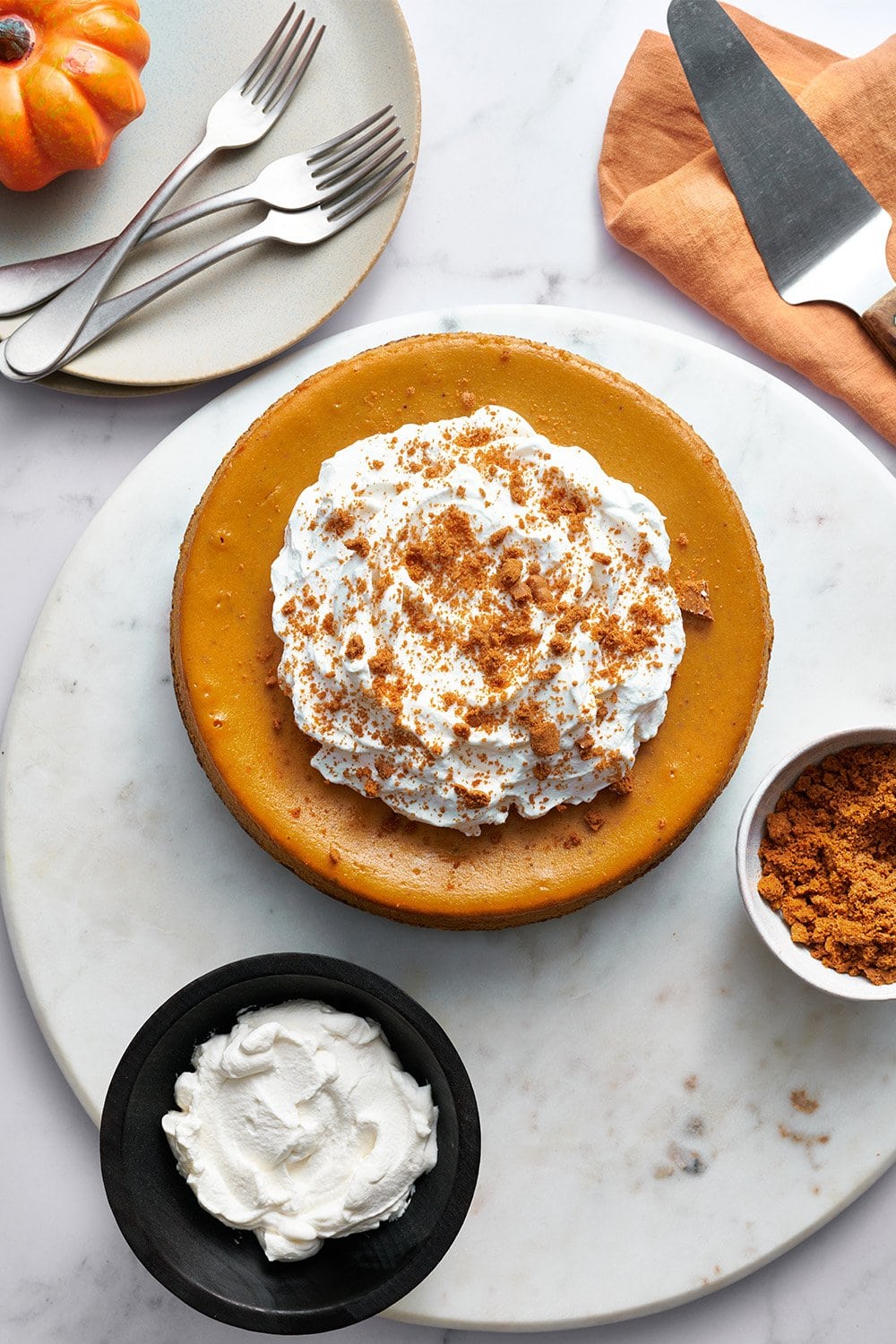
Key Ingredient Notes
This recipe has a few different components: a cookie crust, a creamy pumpkin filling, and a fluffy whipped topping. Most of the ingredients are familiar baking staples, but here’s what really makes this the best pumpkin cheesecake:
- Cream cheese: Always go for full-fat, brick-style cream cheese (not the kind in tubs). The extra fat gives it that ultra-creamy texture. I recommend the Philadelphia brand for a smooth, rich, consistent result.
- Pumpkin puree: Use store-bought canned pumpkin puree, not pumpkin pie filling. The two aren’t the same, as pie filling already contains sugar and spices that can affect the flavor. Homemade puree can also add too much moisture, so canned is my go-to for perfectly silky cheesecake.
- Biscoff cookies: These spiced, caramelized cookies add a warm, buttery depth to the crust. If you can’t find them, swap in gingersnap cookies for a gingersnap crust or graham crackers for a graham cracker crust. Digestive biscuits (in the U.K.) or Amaretti cookies also work beautifully. Use a 1:1 ratio for any substitution.
- Spices: Fresh, high-quality spices are a must. Instead of using pre-made pumpkin pie spice, combine cinnamon, nutmeg, ginger, and cloves for that perfectly balanced, cozy fall flavor.
Check out my Fresh vs. Canned Pumpkin article for more pumpkin baking tips. Or try more of my favorite pumpkin desserts: no-bake pumpkin mousse pie, salted caramel pumpkin cheesecake, or pumpkin chocolate cheesecake bars!
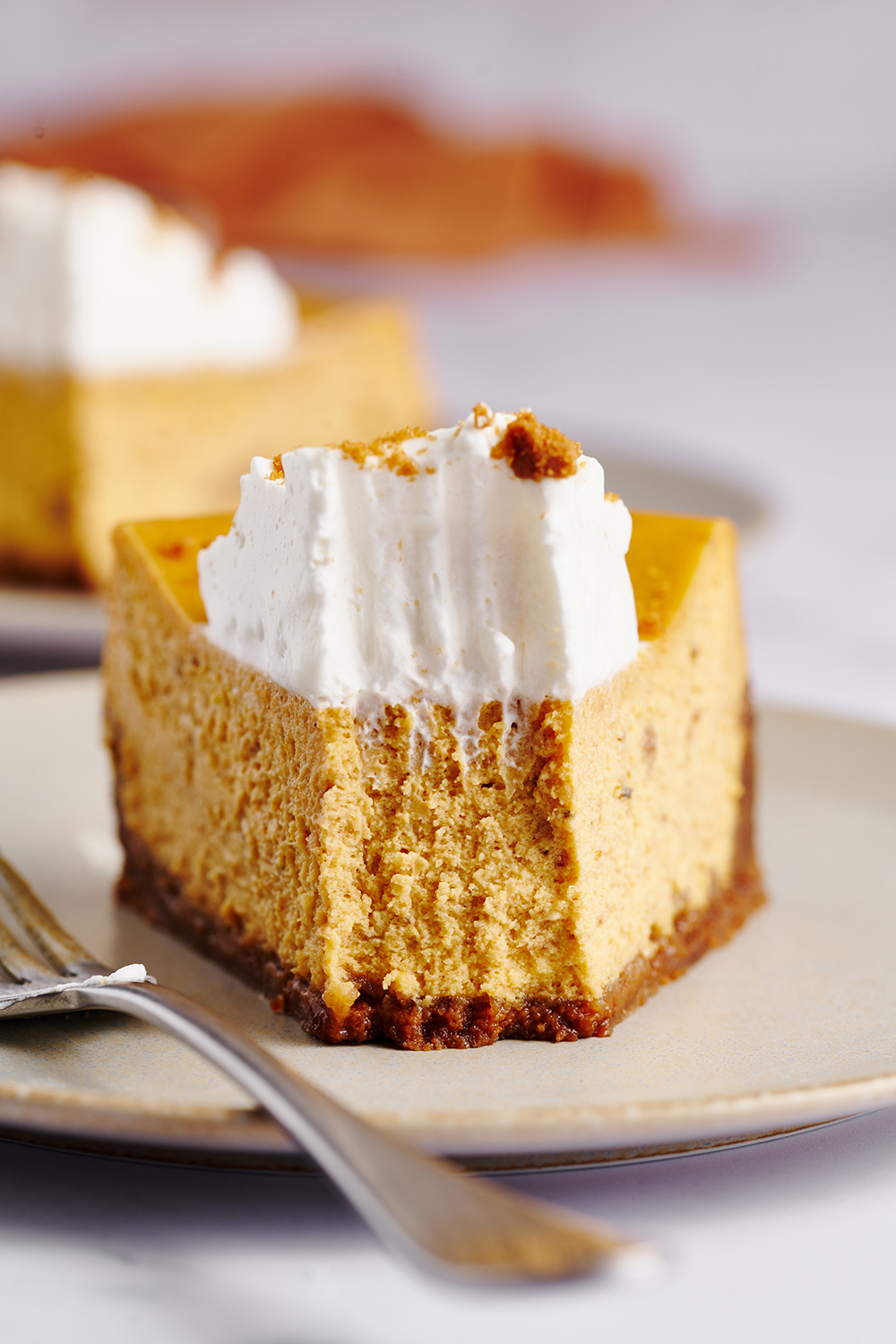
Recommended Equipment
Before getting started, I like to have a few tools on hand! Having the proper equipment makes the process easier and helps achieve that perfectly creamy, crack-free cheesecake.
- Sturdy springform pan: I use a 9-inch heavy-duty springform pan with a 10-cup capacity. If your pan holds less, be careful not to overfill.
- Digital thermometer: A digital thermometer is optional but works great for checking doneness. The cheesecake should register between 140°F and 150°F in the center.
- Mixer: A hand mixer with flat beaters or a stand mixer with the paddle attachment works great for mixing this cheesecake batter.
- Food processor: You’ll need this to pulse the Biscoff cookies into fine crumbs for the crust.
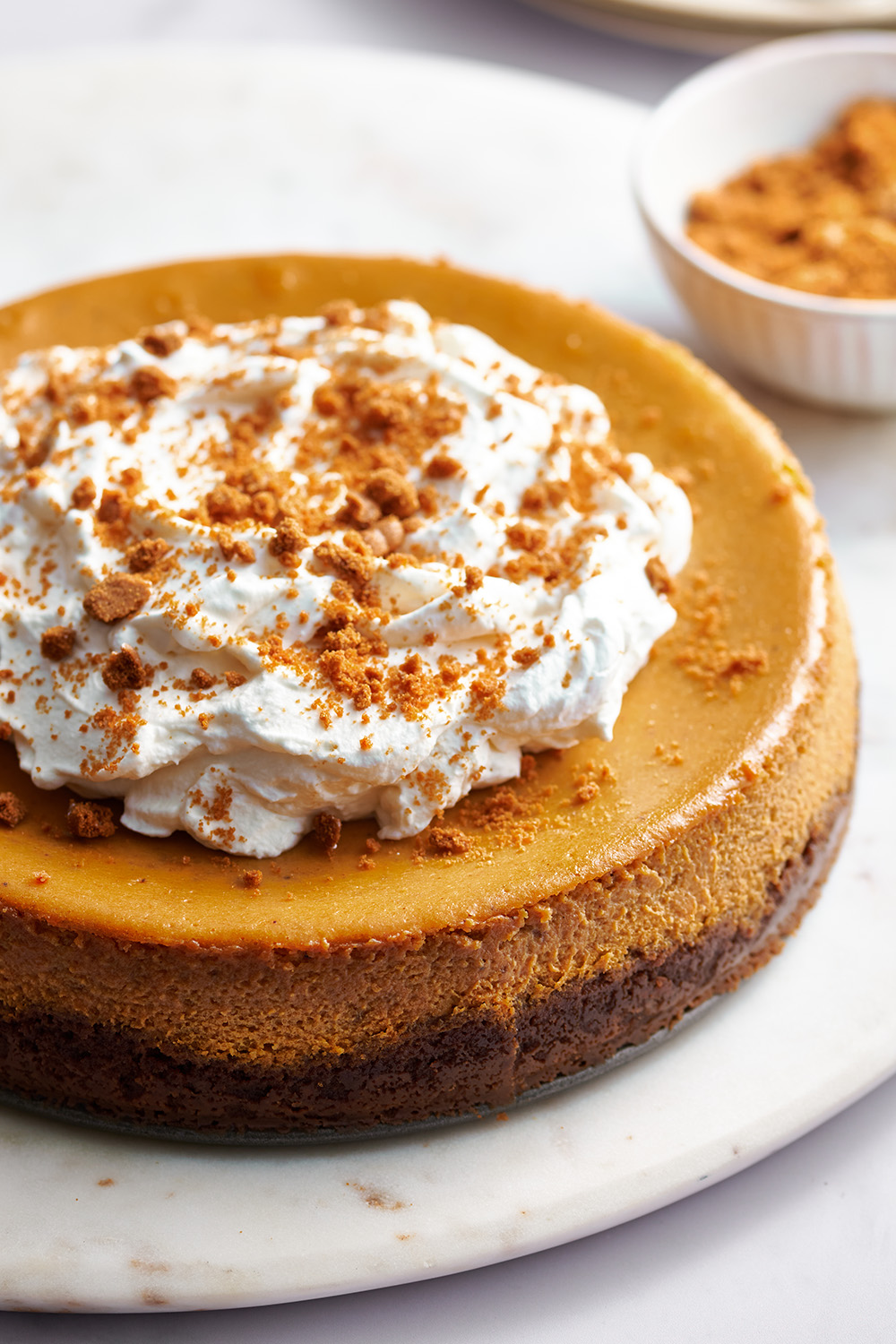
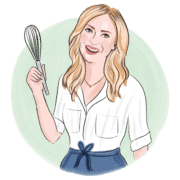
Sprinkle of Science
How to Make Pumpkin Cheesecake
1. Make the Crust
Pulse Biscoff cookies in a food processor until finely ground, then add butter and pulse until the mixture looks like wet sand. Press it firmly into the bottom and halfway up the sides of a 9-inch springform pan (a shot glass or tamper works great). Bake for 10 minutes at 350°F, and let cool on a wire rack. Reduce the oven temperature to 275°F for the cheesecake.
2. Mix the Filling
Beat the softened cream cheese until completely smooth and lump-free. Add both sugars and beat again until well combined, scraping down the bowl as needed. Mix in the pumpkin puree and sour cream until silky, then add the eggs one at a time. Finish with the flour, spices, and vanilla — mixing until just combined. Pour the batter over the cooled crust and smooth the top.
3. Bake Low & Slow
Bake at 275°F for about 1 hour and 45 minutes, until the edges look set but the center still jiggles slightly (like Jell-O). If you’re using a digital thermometer, the internal temperature should be between 140°F and 150°F.
Be careful not to overbake! The oven’s residual heat will continue baking the cheesecake, even after it’s turned off.
4. Cool Gradually
Turn off the oven and crack open the door, letting the cheesecake rest inside for 30 minutes. Then move it to a rack to cool completely. Refrigerate uncovered for at least 6 hours, or overnight, to let the texture set and flavor develop fully.
The result is a smooth, creamy pumpkin cheesecake with a delicious, spiced Biscoff crust — perfect for any fall dessert table!
Troubleshooting Tips
Some of the most common cheesecake mistakes to look out for are cracked tops, runny centers, soggy crusts, and grainy textures. Following the recipe precisely will help prevent these, but just keep the following in mind:
- Use room-temperature ingredients. Cold cream cheese won’t blend smoothly and may cause lumps. Set everything out ahead of time so the batter can mix evenly.
- Don’t over-mix. Beat the cream cheese until completely smooth before adding the eggs. Once the eggs are in, mix only until combined! Over-mixing adds air to the mixture and causes the cheesecake to crack.
- Skip the water bath. This recipe uses the “Low & Slow” method instead of a traditional water bath. It bakes gently at a lower temperature to create a creamy, custard-like texture without the fuss. If your oven runs hot or uneven, you may still have some cracks — and that’s totally normal! I top my recipe with a dollop of tasty whipped cream that will hide any cracks in the surface.
- Chill uncovered. Once you’ve let your cheesecake cool, refrigerate it uncovered for at least 6 hours. This helps firm up the texture and keeps condensation from creating a soggy crust.
Serving and Topping Ideas
This pumpkin cheesecake is already incredible with its homemade whipped cream topping, but don’t be afraid to try other tasty variations! A drizzle of salted caramel sauce or homemade chocolate sauce adds a decadent twist that’s perfect for the holidays.
Because this cheesecake is so rich and creamy, a small slice goes a long way. My family always raves about this impressive centerpiece at our Thanksgiving dessert table!
Storage and Freezing
Store this pumpkin cheesecake in the refrigerator for up to 3 days. Allow it to cool to room temperature completely, then wrap tightly in plastic wrap or place in an airtight container. You can also add a layer of aluminum foil for extra protection. This cheesecake can be stored frozen for up to 2 months. Place the entire cheesecake or individual slices on a baking sheet and freeze until firm. Then wrap it in plastic wrap and place it in a freezer bag or an airtight container. To serve from frozen, thaw the cheesecake overnight in the fridge or individual slices at room temperature for around 30 minutes!
More Holiday Desserts to Try
- Easy Peanut Butter Pie
- French Silk Pie
- Browned Butter Maple Pecan Pie
- Ultimate Classic Cheesecake
- Easy Pumpkin Pie
FAQs
What’s the difference between New York cheesecake and regular baked cheesecake?
New York-style cheesecake is denser and cooked at a higher temperature. It also often has extra egg yolks. Classic cheesecake is less dense, sometimes almost mousse-like. It’s often baked at a lower temperature than New York-style cheesecake and typically uses a water bath.
What spices are best for enhancing the flavor of pumpkin cheesecake?
If the goal is to complement the pumpkin’s flavor, spices like cinnamon, nutmeg, ginger, and cloves will do just that! You can also enhance with vanilla extract or maple syrup.
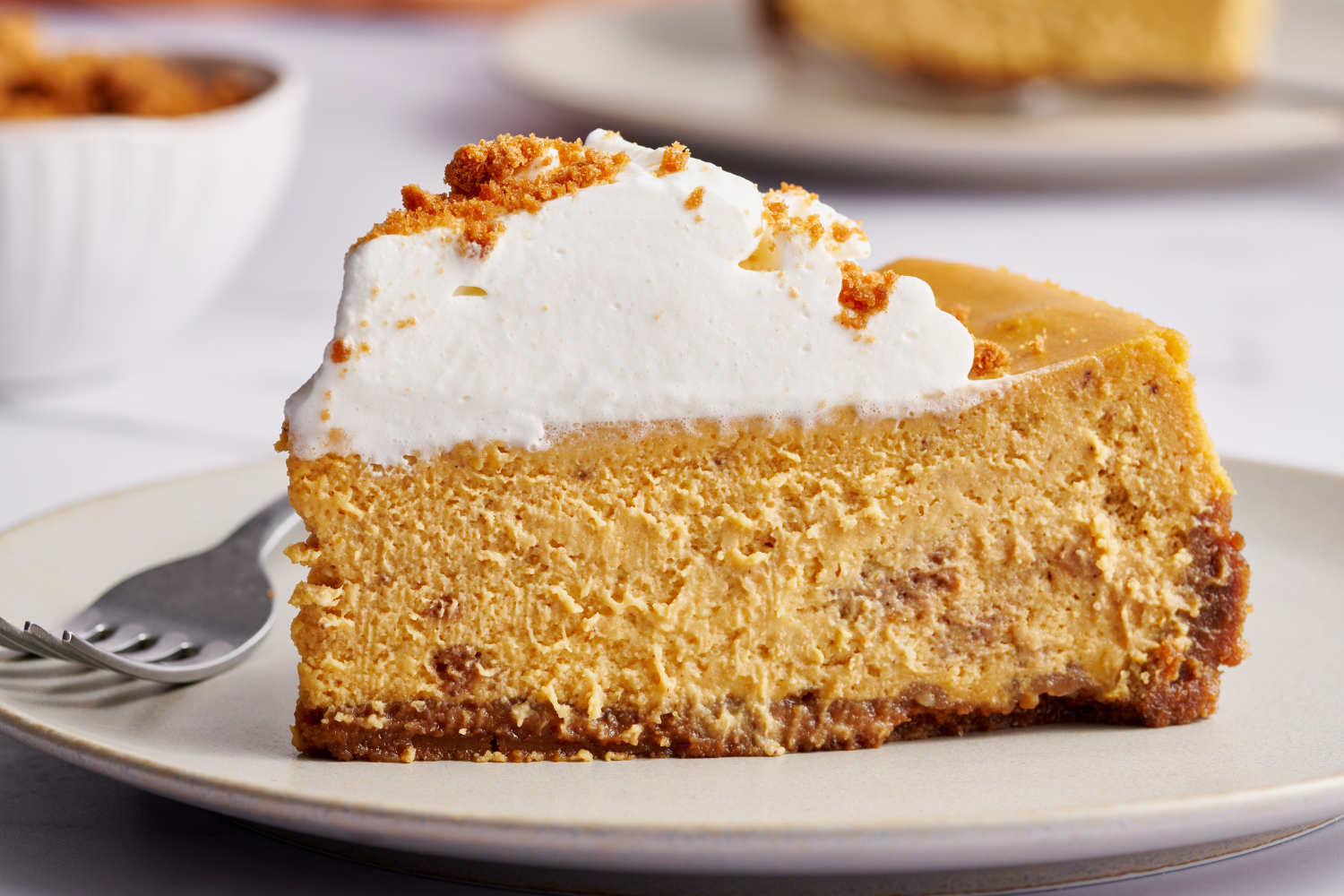
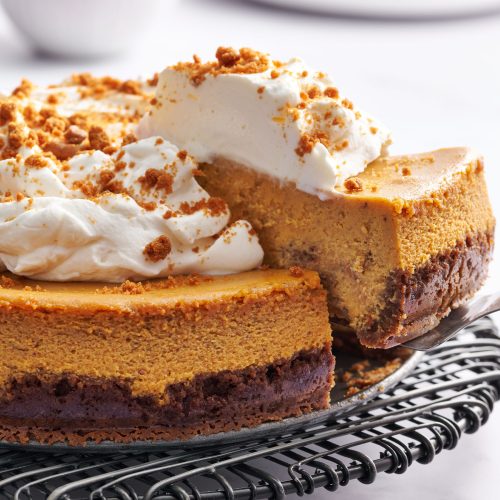
Pumpkin Cheesecake
Email This Recipe
Enter your email, and we’ll send it to your inbox.
Ingredients
For the crust:
- 1 (8.8 ounce or 250 gram) package Biscoff / Speculoos cookies
- 7 tablespoons (99 grams) unsalted butter, melted
For the filling:
- 24 ounces (680 grams) cream cheese, completely softened to room temperature
- ¾ cup (150 grams) granulated sugar
- ¾ cup (150 grams) light brown sugar
- 15 ounces (425 grams) pureed pumpkin
- ¼ cup (57 grams) sour cream or plain full-fat yogurt, at room temperature
- 3 large eggs plus 1 egg yolk, at room temperature
- 2 tablespoons all-purpose flour
- 1 teaspoon ground cinnamon
- ½ teaspoon fresh ground nutmeg
- ¼ teaspoon ground cloves
- ¼ teaspoon ground ginger
- 1 teaspoon vanilla extract
For the topping:
- 1 cup (237 grams) heavy cream, chilled
- ¼ cup (25 grams) powdered sugar
- 1 teaspoon vanilla extract
Instructions
- Preheat the oven to 350°F.
Make the crust:
- Place the cookies in the bowl of a food processor and pulse until finely ground.
- Add the melted butter and pulse until moistened.
- Press into the bottom and halfway up the sides of a 9-inch springform pan (use a shot glass or tamper to assist with this).
- Place the pan on a rimmed baking tray to catch any butter and bake for 10 minutes.
- Place on a wire rack to cool and reduce oven temperature to 275°F.
Make the cheesecake filling:
- In the bowl of an electric mixer fitted with a paddle attachment, beat the cream cheese on medium-high speed until completely smooth and free of clumps, scraping down the bowl and attachment as needed.
- Add the granulated and brown sugars and beat until well combined.
- Scrape down the bowl, then add in the pumpkin puree and sour cream and beat until smooth.
- Add the eggs and yolk, one at a time, then the flour, cinnamon, nutmeg, cloves, ginger, and vanilla, and beat until just combined, being careful not to overmix.
- Pour over baked crust and spread evenly. Tap the pan against the counter a few times to release any bubbles. Tap a spatula against the top of the batter to pop those bubbles. Place the pan on a rimmed baking sheet.
- Bake at 275°F for 1 hour and 45 minutes, or until set and dry at the edges but slightly jiggly and wobbly like Jello in the center with an internal temperature of 140°F-150°F.
- Turn off the oven, crack open the oven door, and allow to cool inside the oven for 30 minutes before removing to a cooling rack to cool completely to room temperature.
- Refrigerate in springform pan for at least 6 hours (preferably overnight but up to 3 days) to allow the texture to firm and the pumpkin spice flavor to develop. Store the cheesecake uncovered to avoid creating condensation, which will create a mushy texture.
Make the topping:
- Whip the heavy cream, powdered sugar, and vanilla extract with an electric mixer for a few minutes until medium peaks form.
- Release the cheesecake from the pan onto a cake stand or serving plate and top with whipped cream. Slice using a big, sharp knife, running it under running hot water, and wiping it off carefully in between cuts. Serve.
Recipe Notes
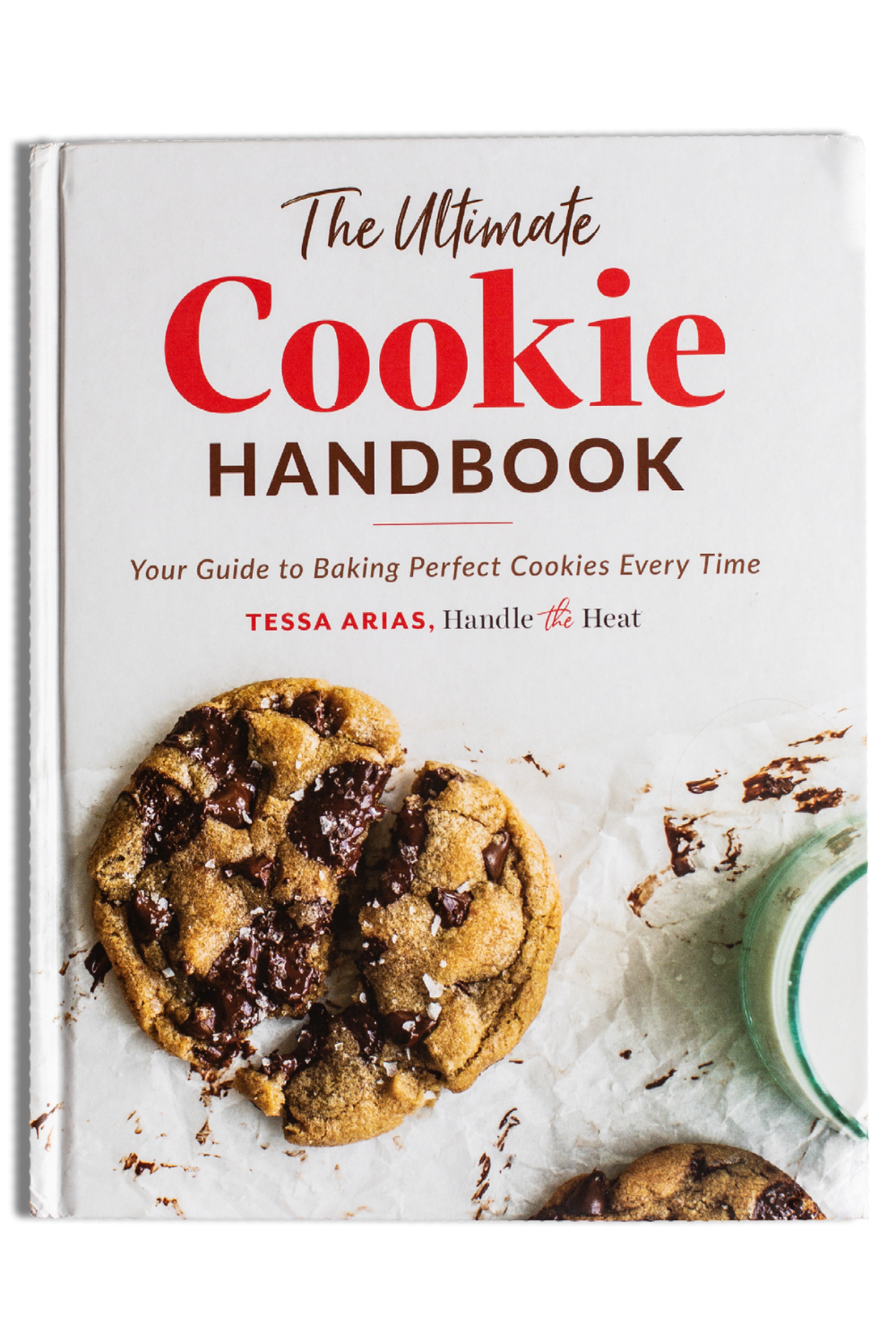
The Ultimate Cookie Handbook
Learn the sweet SCIENCE of cookie baking in a fun, visual way to customize your own recipes frustration-free. Plus, my best 50+ homemade cookies!
This post was originally published in 2009 and has been updated with recipe improvements, additional baking tips, and new photos. Photos by Joanie Simon | The Bite Shot
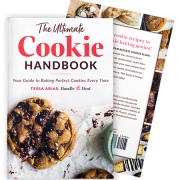
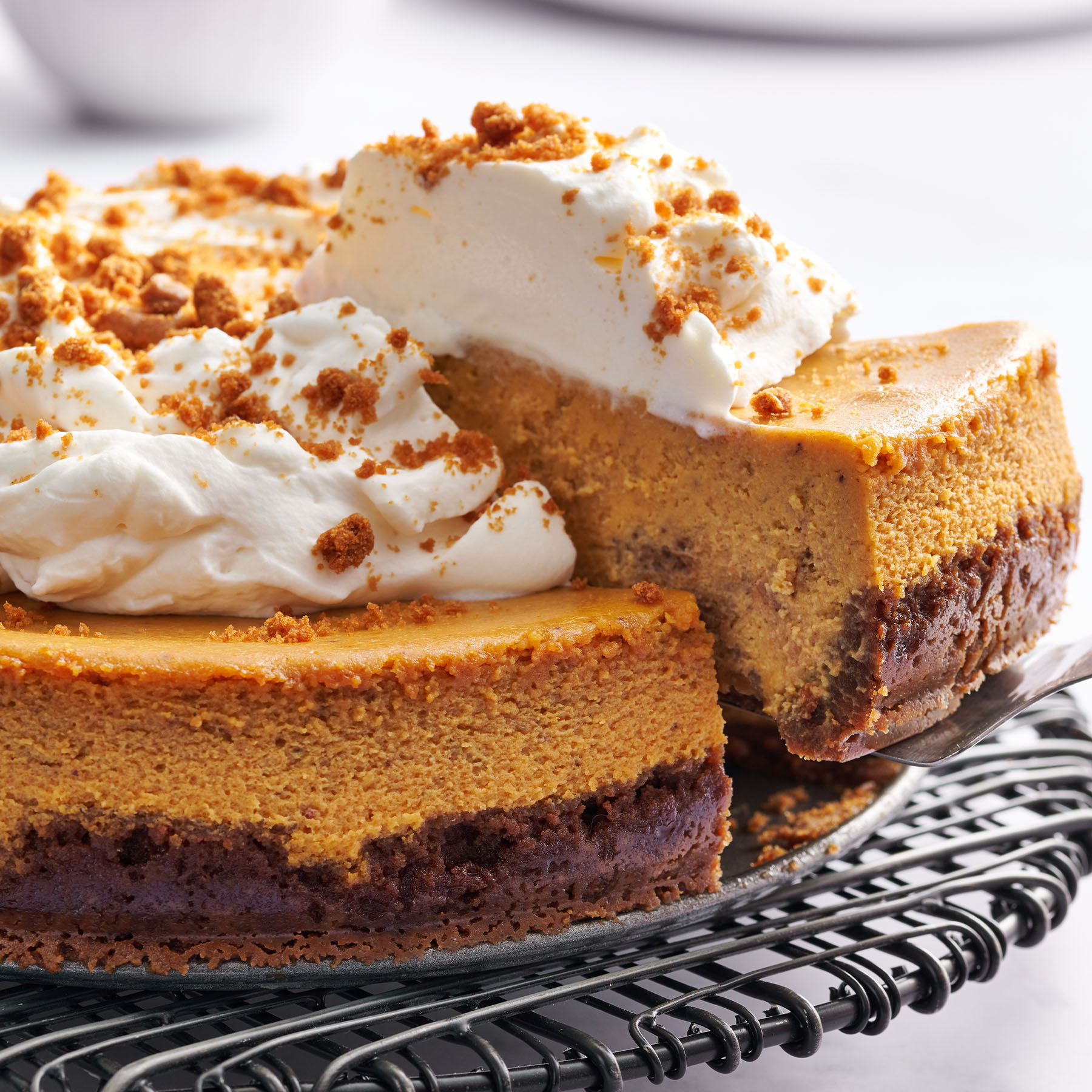
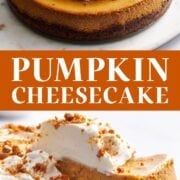

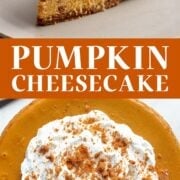
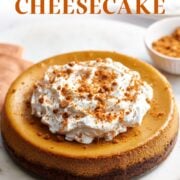
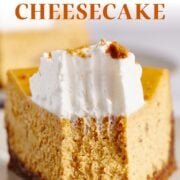
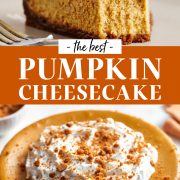
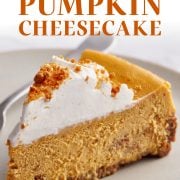
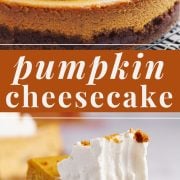

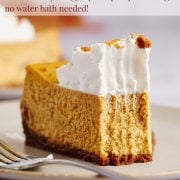
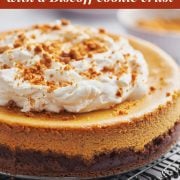
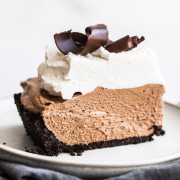
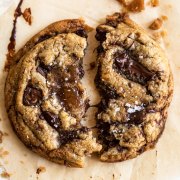

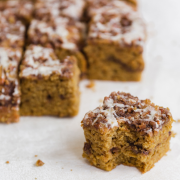
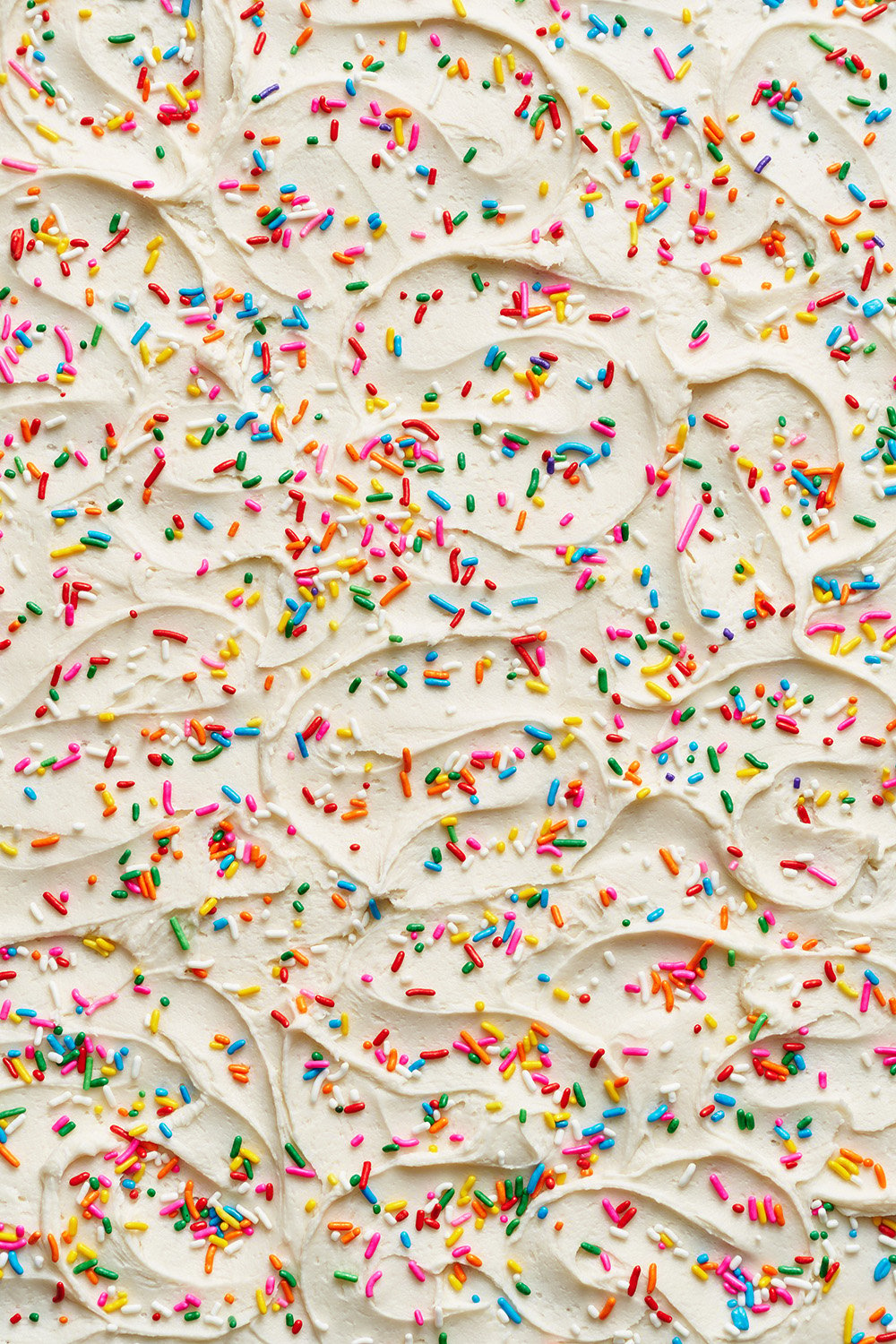
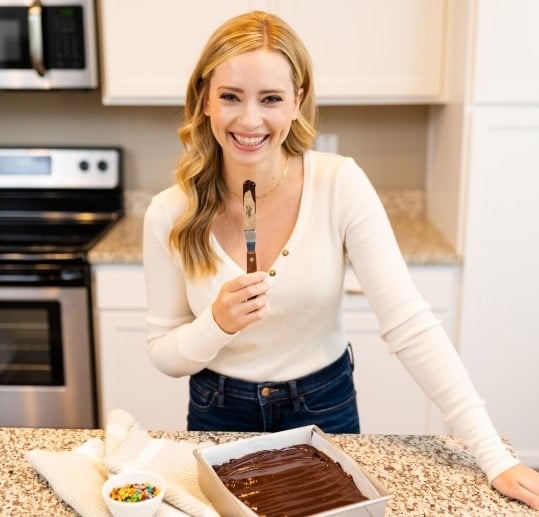
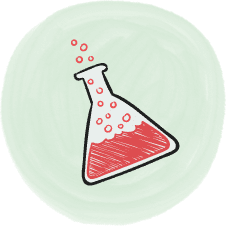
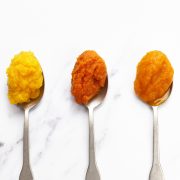
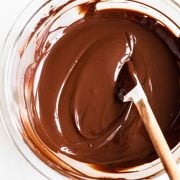
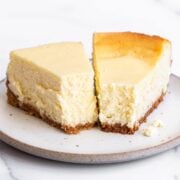
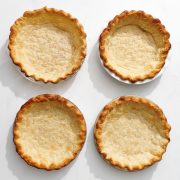








Made this for one of our Thanksgiving after dinner desserts and it was a smash hit. No leftovers! However, I did have one issue. After it cooled in the oven, there was melted butter all over. I’m glad I put a sheet of foil under the pan in the oven or there would have been melted butter all over the place. After the cheesecake was completely cooled and out of the fridge, I was disappointed in the crust. It was very greasy and stuck to the bottom of the pan and for the most part the slices didn’t come out of the pan looking very good. What crust did come out attached to the filling, was over buttery and tasted bad. The cheesecake filling however was great. What did I do wrong or could have to prevent such “crummy” crust?
We absolutely love this cheesecake and it’s always the first request for family gatherings and always a big hit.
I want to try a water bath with it and wonder what you would recommend if anything over your normal water bath instructions
So happy to hear you love this recipe, George! We love this recipe because it uses the low-and-slow method of baking, but if you prefer to use a water bath, feel free to follow the instructions as written in our How to Make a Water Bath article. There shouldn’t be any other changes required. Let us know how it goes!
I was worried while I was making it that I wasn’t doing it correctly but it is so crazy delicious! My grown daughter, who doesn’t like anything pumpkin, took some home with her after Thanksgiving dinner.
This recipe got the ultimate designation at our house called “OMG Excellent!” There are only a few recipes that have received that designation.
Thank you for sharing it!
So happy to hear this was such a hit, Dee! 🙂
This cheesecake is so delicious! It was enjoyed by everyone. I did change a few things to make it gluten free. For the crust I used the same amount (by weight) of gf graham crackers (about 14 full sheets) and added 3 Tbsp sugar, 1/2 tsp. cinnamon, and 1/2 tsp. ground ginger. I also used 1Tbsp gf cornstarch in place of the flour.
I want to make this and was wondering if a chocolate cookie crust would taste good with this recipe. otherwise I’ll stick with your crust!
Hi Sue! Tessa’s Pumpkin Chocolate Cheesecake Bars use a chocolate cookie base, so I don’t see why that wouldn’t be delicious here! Let us know how it goes 🙂